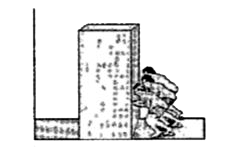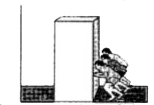Iqbal has to push a lighter box and Seema has to push a similar heavier box on the same floor. Who will have to apply a larger force and why?
To determine who will have to apply a larger force between Iqbal and Seema when pushing their respective boxes, we can analyze the situation step by step.
Step 1: Understand the Forces Acting on the Boxes
Both Iqbal and Seema are pushing boxes on the same floor, which means the coefficient of friction (μ) between the boxes and the floor is the same. The forces acting on each box include:
- The gravitational force (weight) acting downwards (mg).
- The normal force (N) acting upwards, which balances the weight of the box.
- The frictional force (F_friction) acting in the opposite direction to the applied force.
Step 2: Identify the Masses of the Boxes
- Iqbal is pushing a lighter box, which we can denote as having mass m.
- Seema is pushing a heavier box, which we can denote as having mass M (where M > m).
Step 3: Calculate the Normal Force
The normal force for both boxes can be expressed as:
- For Iqbal's box: N=mg
- For Seema's box: N′=Mg
Step 4: Calculate the Frictional Forces
The frictional force can be calculated using the formula:
Ffriction=μ×N
Thus, the frictional forces for both boxes are:
- For Iqbal's box: Ffriction=μmg
- For Seema's box: F′friction=μMg
Step 5: Compare the Forces Required to Move the Boxes
To move the boxes, Iqbal and Seema must apply forces that overcome the frictional forces:
- Iqbal must apply a force FIqbal≥μmg
- Seema must apply a force FSeema≥μMg
Since M>m, it follows that:
FSeema≥μMg>μmg≥FIqbal
Conclusion
Seema will have to apply a larger force than Iqbal because the frictional force opposing her push is greater due to the heavier weight of her box. Therefore, the answer is that Seema will have to apply a larger force.
---
Both Iqbal and Seema are pushing boxes on the same floor, which means the coefficient of friction (μ) between the boxes and the floor is the same. The forces acting on each box include:
- The gravitational force (weight) acting downwards (mg).
- The normal force (N) acting upwards, which balances the weight of the box.
- The frictional force (F_friction) acting in the opposite direction to the applied force.
- Iqbal is pushing a lighter box, which we can denote as having mass m.
- Seema is pushing a heavier box, which we can denote as having mass M (where M > m).
The normal force for both boxes can be expressed as:
- For Iqbal's box: N=mg
- For Seema's box: N′=Mg
The frictional force can be calculated using the formula:
Ffriction=μ×N
Thus, the frictional forces for both boxes are:
- For Iqbal's box: Ffriction=μmg
- For Seema's box: F′friction=μMg
To move the boxes, Iqbal and Seema must apply forces that overcome the frictional forces:
- Iqbal must apply a force FIqbal≥μmg
- Seema must apply a force FSeema≥μMg
FSeema≥μMg>μmg≥FIqbal
Seema will have to apply a larger force than Iqbal because the frictional force opposing her push is greater due to the heavier weight of her box. Therefore, the answer is that Seema will have to apply a larger force.
Topper's Solved these Questions
Similar Questions
Iqbal has to puch a lighter box and seema has to puch a similar heavier box on the same floor . Who will have to apply a larger force and why ?
View SolutionIqbal has to push a lighter box and Seema has to push a similar heavier box on the same floor. Iqbal will have to apply a larger force. State true or false with reasons.
View Solution
Knowledge Check
- Question 1 - Select One
You are pushing a wooden crate across the floor at a constant speed. You decide to change the orientation of crate such that area of contanct with floor becomes half. In the new orientation, to push the same crate across the same floor with the same constant speed, the force that you apply must be about__________ as the force required before you changed the crate's orientation.
A4 times as greatB2 times as greatCequally greateD1/2 as great
Neeraj has to push a lighter box and Sanjeev a heavier box. Who will have to apply a larger force and why?
View SolutionIt is easier to push an empty box than to push the box full of books.Why?
View SolutionA large box, placed on the ground, has to be shifted up to a wall, as shown in the given figure. Three boys push the box together. They have to apply a large amount of force to move the box. The motion of the box is opposed by the frictional force between the box and ground.

If wheels were present below the box, then they would have to applyView SolutionA large box, placed on the ground, has to be shifted up to a wall, as shown in the given figure. Three boys push the box together. They have to apply a large amount of force to move the box. The motion of the box is opposed by the frictional force between the box and the ground.

If wheels were present below the box, then they would have to applyView SolutionDescribe how the two figures at the right are alike and how they are different. Which box has larger lateral surface area?
View SolutionThree identical blocks, each having a mass M, are pushed by a force F on a frictionless table as shown in (figure) What is the acceleration of the blocks? What is net force on block A? What force does A apply on B? What force does B apply on C? show action reaction pairs on the contact surface of the blocks.
View SolutionArun and Asheesh, are pushing a box kept on the ground, from opposite sides. Arun is pushing the box towards the right with a force of 25N and Asheesh is pushing the box towards the left with a force of 43N. Calculate the magnitude and direction of the frictional force that must be acting between the box and the ground
View Solution

